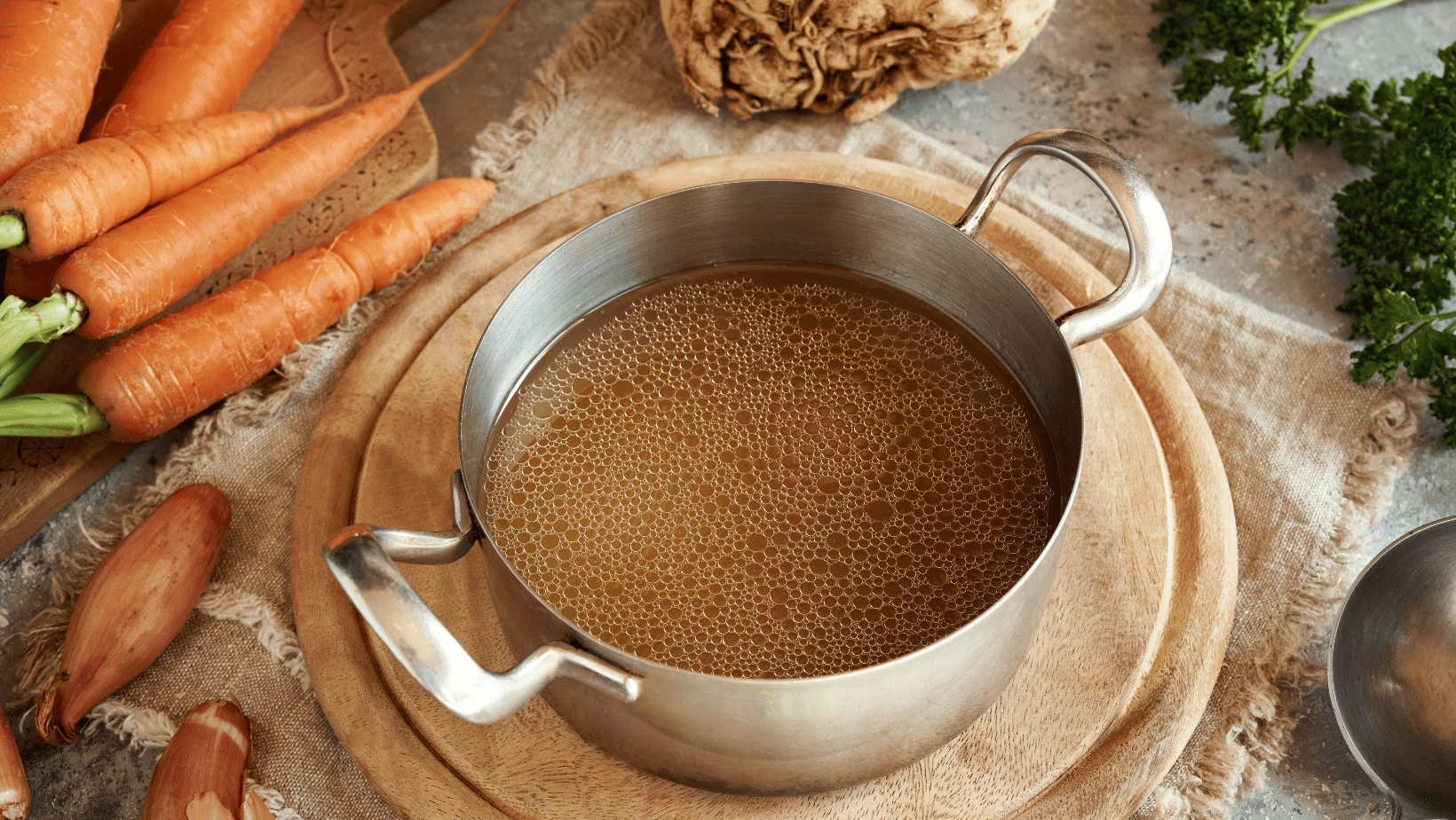How to Make Delicious Bone Broth in 5 Easy Steps
If you’re looking for a nutrient-rich and delicious way to boost your overall health, look no further than bone broth. This savory liquid has been used for centuries as a natural remedy to improve gut health, support joint health, and strengthen the immune system.
Understanding the Benefits of Bone Broth
Bone broth has been a popular health food for centuries, and for good reason. Not only is it a tasty and easy addition to one’s diet, but it’s also packed with nutrients that are essential for maintaining good health.
Nutritional Value
Bone broth is a nutritional powerhouse containing a wide range of essential vitamins and minerals. It’s packed with minerals like calcium, magnesium, and phosphorus, which are vital for maintaining healthy bones and teeth. Also filled with amino acids like glycine, proline, and glutamine, essential for maintaining good overall health, bone broth can significantly impact one’s diet.
A favorite benefit for many, bone broth is jammed with collagen, a protein that is essential for healthy skin, hair, and nails. Beyond that, collagen is also crucial for maintaining healthy joints, as it helps cushion and lubricate them.
Boosts Immune System
Drinking bone broth can provide a boost to the immune system, thanks to its high concentration of nutrients and minerals. The amino acids in bone broth also help to reduce inflammation and fight off infections.
Studies have shown that bone broth can help to strengthen the immune system, making it more resistant to infections and diseases. It’s also been shown to be effective in reducing the severity and duration of colds and flu.
Supports Joint Health
The gelatin found in bone broth has been shown to be beneficial for joint health. This natural compound helps to reduce inflammation in the joints and can also help to improve mobility. Add the fact that collagen found in bone broth can help to strengthen the bones and cartilage; it is a no-brainer for those who deal with aches and pains.
Improves Gut Health
Bone broth is also known for its gut-healing properties. The minerals and amino acids it contains can help to restore the lining of the gut and reduce inflammation, improving overall digestive function.
Research has supported bone broth’s effectiveness in treating conditions like leaky gut syndrome, IBS, and Crohn’s disease. It’s also been shown to be effective in reducing symptoms like bloating, constipation, and diarrhea.
Whether looking to boost your immune system, support your joint health, or improve your digestive function, bone broth is an excellent choice if you are ready to take a simple step toward better overall health.
Gathering Your Ingredients
Bone broth is a nutrient-dense and flavorful addition to any diet. It’s also easy to make at home with just a few simple ingredients. Here’s what you’ll need:
Choosing the Right Bones
When it comes to making bone broth, the quality of your bones is key. Look for bones from grass-fed or pasture-raised animals, as these will have more nutrients and fewer toxins. You can use bones from beef, chicken, turkey, or fish, depending on your preference. If you’re using beef bones, opt for marrow bones or knuckle bones, as these will give your broth a rich, gelatinous texture.
Before you start making your broth, it’s a good idea to roast the bones in the oven for 20-30 minutes, which will enhance their flavor and give your broth a deeper color.
Selecting Fresh Vegetables
Vegetables can add extra nutrition and flavor to your bone broth. Choose fresh, organic vegetables like carrots, onions, garlic, and celery. These vegetables are packed with vitamins and minerals that will infuse your broth with added health benefits.
When selecting your vegetables, be sure to wash them thoroughly and chop them into large pieces. This will make them easier to strain out later.
Herbs and Spices for Flavor
Adding herbs and spices to your bone broth can give it a delicious flavor and provide extra health benefits. Try adding ginger, turmeric, rosemary, or thyme. These herbs are known for their anti-inflammatory properties and can help to boost your immune system.
You can also experiment with different spices like cumin, coriander, or paprika, depending on your taste preferences.
The Importance of Water Quality
The quality of the water you use is also important when making bone broth. Choose filtered, purified, or spring water to ensure the best flavor and nutrient content. Tap water can contain chlorine and other chemicals that can affect the taste and quality of your broth.
It’s also important to use enough water when making your broth. You want to cover the bones and vegetables with at least 2 inches of water to ensure that they’re fully submerged.
Now that you have your ingredients, it’s time to start cooking! Follow the recipe below for a delicious and nutritious bone broth.
Step 1: Roasting the Bones
Preparing the Bones
Before you roast your bones, it’s important to properly prepare them to ensure the best possible flavor. Start by washing the bones under cold running water to remove any dirt or debris. Next, use a sharp knife to remove any meat or fat that may still be attached to the bones. This will prevent any unwanted flavors from being introduced during the roasting process.
Roasting Time and Temperature
Once your bones are prepared, it’s time to roast them to perfection. Preheat your oven to 400 degrees Fahrenheit and place the bones in a roasting pan. Sprinkle them generously with salt and pepper to enhance their natural flavors. Roast the bones in the oven for 30-45 minutes, or until they are browned and fragrant.
Tips for a Richer Flavor
If you’re looking to take your bone broth to the next level, there are a few additional steps you can take to enhance its flavor. Consider adding onions, garlic, and other vegetables to the roasting pan alongside the bones. This will infuse the broth with additional savory flavors and aromas. You can also try adding a tablespoon of apple cider vinegar to the pan. This will help to pull out important minerals from the bones, resulting in a richer and more nutritious broth.
Another tip for a richer flavor is to use a mix of different types of bones. For example, you might use a combination of beef bones, chicken bones, and pork bones. This will create a more complex flavor profile and provide a wider range of nutrients.
Finally, don’t be afraid to experiment with different herbs and spices to customize the flavor of your broth. Consider adding bay leaves, thyme, or rosemary for a more herbaceous flavor. Alternatively, you might try adding a pinch of turmeric or ginger for a warming, spicy kick.
Step 2: Simmering the Broth
Combining Ingredients
Now that you have roasted the bones, it’s time to combine all the ingredients to make the broth. Transfer the roasted bones to a large pot and add your vegetables, herbs, and spices. You can use any vegetables you like, but some popular options include carrots, onions, celery, and garlic. The herbs and spices you add will depend on your personal preference, but some common choices include bay leaves, thyme, and peppercorns.
When adding the vegetables, be sure to wash them thoroughly and chop them into large pieces. This will help to release their flavor and nutrients into the broth. Cover the ingredients with water and bring to a simmer.
Simmering Duration
Once the broth is simmering, it’s time to let it cook for a while. The longer you simmer the broth, the richer and more flavorful it will be. Most recipes recommend simmering for 12-24 hours, but you can adjust the time based on your preferences.
As the broth simmers, you may notice foam rising to the surface. This is normal and can be skimmed off with a spoon. Skimming the foam will help to keep the broth clear and free of impurities.
Monitoring the Heat
While the broth is simmering, it’s important to keep an eye on the heat. Bone broth can easily boil over if left unattended, so you may need to adjust the heat to maintain a gentle simmer.
It’s also a good idea to check the water level periodically and add more as needed. As the broth cooks, the water will evaporate, so you want to make sure there is always enough liquid to cover the ingredients.
When the broth is done simmering, remove it from the heat and let it cool slightly. Strain the broth through a fine-mesh sieve to remove any solids, and discard the bones and vegetables.
Final Thoughts
Making your own bone broth is a simple and rewarding process that can provide a wealth of health benefits. Whether you drink it on its own or use it as a base for soups and stews, bone broth is a delicious and nutritious addition to any diet. So why not give it a try and see how easy it is to make your own homemade broth?
Organixx Clean Sourced Collagens blend contains five types of collagen from four sources. What’s more, it’s combined with targeted nutrients such as zinc, vitamin C, and vitamin B6 which specifically enhance the bioavailability and potency of collagen. Clean Sourced Collagens is formulated from the ground up to enhance and support your body’s natural ability to heal and rebuild itself from the INSIDE out.





Comments